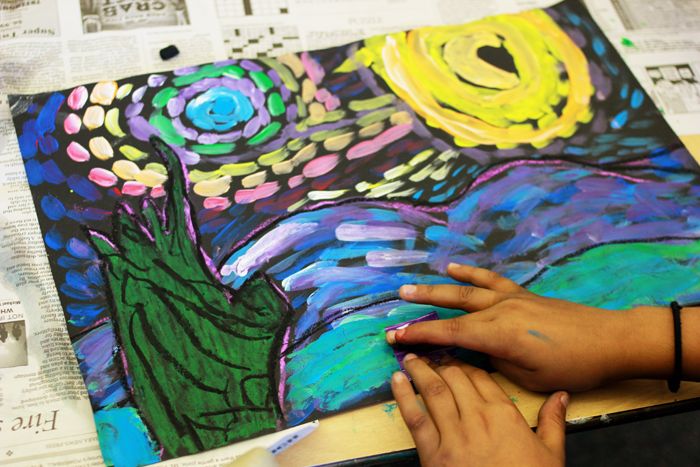Van Gogh’s painting style lesson plan: Painting for kids
Summary:
Students will learn about Vincent Van Gogh as they create a painting in his style.
About Vincent Van Gogh
Vincent Van Gogh (born 1853, died 1890) is probably one of the most well known and influential artists of the 19th century. The son of a Dutch pastor, the young Van Gogh worked for picture dealers along with his brother Theo. He also taught in two English schools and in his twenties, became a missionary in the coal mining district of the Barniage in Belgium, where he lived among the miners and shared their hardships.
During his life, Van Gogh lived in various locations including Brussels, The Hague, Antwerp and Drenthe and in his travels, taught himself to draw and paint, in addition to taking the occasional art lesson. He moved to Paris at age 33 to live with his brother Theo (who was working in a gallery), and it was there that he came into contact with the work of the Impressionists.
Where before his work was dark in color with heavy forms and subject matter depicting peasants at work in the fields, in Paris, Van Gogh’s paintings began to take on a somewhat Impressionistic feel. Flowers, portraits, self portraits and images of Paris appeared in his work. He went to Arles (later joined by fellow artist Paul Gauguin) at the age of 35 and upon arriving painted landscapes and portraits full of vivid colors and passionate feelings. In the years following 1888, he spent time in an insane asylum and eventually – at the age of 37 – took his own life. It was during the months approaching his death that Van Gogh created some of the most vibrant, expressive paintings known to man. In all, he produced an enormous volume of work – much of which was left in the care of his brother Theo’s son.
What You Need:
- Van Gogh prints:
- Starry Night (link to ArtChive)
- Self Portrait (link to ArtChive)
- Irises (link to ArtChive)
- white painting paper
- tempera or acrylic paints (or oil pastels)
- brushes (large and small)
- water containers
- Pre Writing Chart (see end of lesson for details)
What You Do:
- Start this lesson by looking at Starry Night.
- Ask your students to describe the painting and its main ideas.
- Focus on the wind. Ask your students how Van Gogh used brush strokes to make the wind (swirls etc.) Point out that the swirls are made with small brush strokes and many different shades of blue.
- Then move to a demonstration of how to paint like Van Gogh.
- On the top 2/3 of the paper paint swirly shapes. Emphasize allowing the paint to mix on the paper, Van Gogh did that.
- End the sky by adding small brush strokes over the larger swirls. This gives the impression of many small strokes.
- To close your lesson, ask the students to identify the same skills (small strokes, swirls, mixing colors) in one of the other prints.
- On the second day of this lesson focus on the background of Starry Night. Have the children tell you what they see and then demonstrate how to paint like Van Gogh. I like to focus on the mountains and the town.
- On the third day, I like to change my focus to the Irises. We finish this painting by describing how the irises are made and painting irises in the foreground of our paintings. The results are beautiful. This lesson is highly successful in elementary grades.
“Because Maryland has performance task testing, I like to extend this lesson to include an analysis and writing piece. I start by asking my students to fill out a form asking “How did I use Van Gogh‘s skills to create my painting?” The chart lists three rows:
- Van Gogh‘s skill
- How I used the skill
- Where I used the skill.
By completing the chart the children have created a prewriting guide to answer the question. (I like to call it the question of the day) Then I have my students write a paragraph or more about how they painted like Van Gogh. Parents love to see their children’s writing displayed in the hallway with the finished painting.
Good Luck!” – H. Bachman
